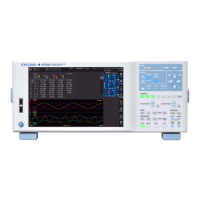1-3
IM WT5000-01EN
Harmonic Measurement Functions
Function Description Input Element Wiring Unit
U(k) Rms voltage of harmonic order k Yes Yes
I(k) Rms current of harmonic order k Yes Yes
P(k) Active power of harmonic order k Yes Yes
S(k) Apparent power of harmonic order k Yes Yes
Q(k) Reactive power of harmonic order k Yes Yes
λ(k) Power factor of harmonic order k Yes Yes
Φ(k) Phase difference between the voltage
and current of harmonic order k
Yes No
ΦU(k) Phase difference between the
fundamental signal, U(1), and
harmonic voltage U(k)
Yes No
ΦI(k) Phase difference between the
fundamental signal, I(1), and harmonic
current I(k)
Yes No
Z(k) Impedance of the load circuit Yes No
Rs(k) Series resistance of the load circuit Yes No
Xs(k) Series reactance of the load circuit Yes No
Rp(k) Parallel resistance of the load circuit Yes No
Xp(k) Parallel reactance of the load circuit Yes No
Uhdf(k) Harmonic voltage distortion factor Yes No
Ihdf(k) Harmonic current distortion factor Ye s No
Phdf(k) Harmonic active power distortion factor Yes No
Uthd Total harmonic voltage distortion Yes No
Ithd Total harmonic current distortion Yes No
Pthd Total harmonic active power distortion Yes No
Uthf Telephone harmonic factor of the
voltage
Yes No
Ithf Telephone harmonic factor of the
current
Yes No
Utif Telephone influence factor of the
voltage
Yes No
Itif Telephone influence factor of the
current
Yes No
hvf Harmonic voltage factor Yes No
hcf Harmonic current factor Yes No
K−factor K factor Yes No
ΦUi−Uj
1
Phase difference between the
fundamental voltage of element i,
Ui(1), and the fundamental voltage of
element j, Uj(1)
No Yes
ΦUi−Uk
1
Phase difference between Ui(1) and
the fundamental voltage of element k,
Uk(1)
No Yes
ΦUi−Ii
1
Phase difference between Ui(1) and
the fundamental current of element i,
Ii(1)
Yes
2
Yes
ΦUj−Ij
1
Phase difference between Uj(1) and
the fundamental current of element j,
Ij(1)
No Yes
ΦUk−Ik
1
Phase difference between Uk(1) and
the fundamental current of element k,
Ik(1)
No Yes
1 i, j, and k are input element numbers. For example, when the number of input elements in wiring unit ΣA is
six and the wiring system of elements 1, 2, and 3 is three phase, four wire, i is 1, j is 2, and k is 3. ΦUi – Uj
represents ΦU1 – U2, the difference between the fundamental voltage signal of element 1, U1(1), and the
fundamental voltage signal of element 2, U2(1). In the same way ΦUi – Uk, ΦUi – Ii, ΦUj – Ij, and ΦUk−Ik
represent to ΦU1 – U3, ΦU1 – I1, ΦU2 – I2, and ΦU3 – I3, respectively.
2 Setting i to an input element, is the same as setting k to 1 in Φ(k).
1 Items That This Instrument Can Measure

